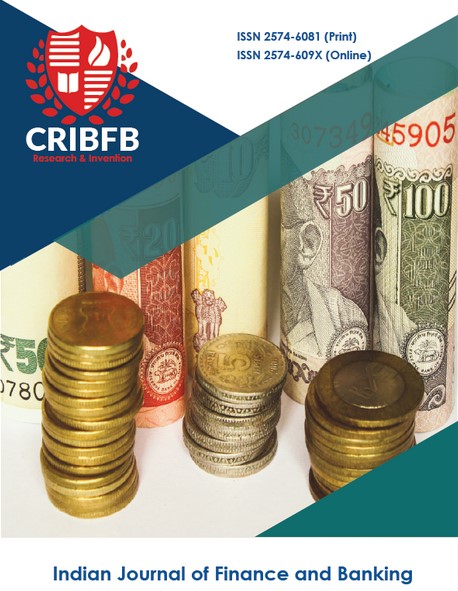INDIAN MOBILE BANKING IN POST COVID-19: AN ANALYTICAL STUDY AND GRATIFICATION FROM THE ASPECT OF KANO MODEL
Main Article Content
Abstract
The purpose of the present research paper is to understand the research questions related to M-banking. It is the time call to take up Virtual Banking (VB) with Zero Contact Banking (ZCB) as a preventive measure to COVID-19. The study also admits the comparative analysis on the gratification of M-banking users considering factors/attributes of the Kano Model. The researcher has undertaken Integrative Approach (IA) for both, related to literature reviewed and survey so far observed. Both primary data through well-structured questionnaires from 900 M-banking users of SBI, HDFC, and Citi Bank (300 from each) and secondary data from published sources have been cantered and cited to understand the syntactic research gap. The researcher has followed Stratified Random Sampling for sample banks considering the date of establishment, volume and value of M-banking transactions, number of employees, and Convenient Random Sampling for M-banking users, to make the sample representative. The objectives were studied thoroughly and hypotheses were tested in SPSS. The researcher has used Kolmogorov-Smirnov (D-Statistic) and Shapiro-Wilk test (W-Statistic) to test data normality, Cronbachs’ Alpha to test Data Reliability, Descriptive Statistics i.e. frequency and per cent count to describe data and Chi-square to measure significant associations and differences if any. The researcher has drawn an epilogue purely on the basis of data collection and analysis. The researcher has conducted Pearson’s Product Movement Correlation, to suggest a correlation on Y-intercept Model to show an association between volume and value of M-banking transactions of SBI, HDFC, and Citi Bank and suggested a model fit to regression equation. This paper gives a unique insight into KANO model.
JEL Classification Codes: A1, A30, C1, G17, Y8.
Downloads
Article Details
Section
How to Cite
References
Cherian, J., Gaikar, V., Paul, R., & Pech, R. (2021). Corporate culture and its impact on employees’ attitude, performance, productivity, and behavior: An investigative analysis from selected organizations of the United Arab Emirates (UAE). Journal of Open Innovation: Technology, Market, and Complexity, 7(1), 45, 1-27 https://doi.org/10.3390/joitmc7010045
Cherian, J., Jacob, J., Qureshi, R., & Gaikar, V. (2020). Relationship between entry grades and attrition trends in the context of higher education: Implication for open innovation of education policy. Journal of Open Innovation: Technology, Market, and Complexity, 6(4), 199. 1-17. https://doi.org/10.3390/joitmc6040199
Cherian, J., Gaikar, V., & Raj P, P. (2020). Do leadership styles impact organizational performance in the UAE context? A study. International Journal of Mechanical Engineering and Technology, 11(9), 23-32.
Durkin, M., O'Donnell, A., Mullholland, G., & Crowe, J. (2007). On e‐banking adoption: from banker perception to customer reality. Journal of Strategic Marketing, 15(2-3), 237-252. https://doi.org/10.1080/09652540701318815
Laforet, S., & Li, X. (2005). Consumers’ attitudes towards online and mobile banking in China. International journal of bank marketing, 23(5), 362-380. https://doi.org/10.1108/02652320510629250
Matzler, K., & Hinterhuber, H. H. (1998). How to make product development projects more successful by integrating Kano's model of customer satisfaction into quality function deployment. Technovation, 18(1), 25-38. https://doi.org/10.4236/jssm.2015.85079
Poddar, B., Erande, Y., Chitkara, N., Bhansal, A., & Kejriwal, V. (2016). Digital and Beyond New Horizons in Indian Banking. The Boston Consulting Group, FICCI, Indian Bank’s Association: Mumbai, India, 1-43. https://doi.org/10.55529/jcfmbs.31.23.34
Reserve Bank of India - Press Releases. (2023). Retrieved February 5, 2023, from https://www.rbi.org.in/scripts/BS_PressReleaseDisplay.aspx?prid=3058
Saeidipour, B., Vatandost, T., & Akbari, P. (2012). Study the effects of development of electronic banking on customer satisfaction levels by using Kano model (Case Study: Refah Bank of Kermanshah, Iran). International Research Journal of Applied and Basic Sciences, 3(5), 950-960. https://ssrn.com/abstract=2145494
Sharma, S. K., & Sharma, M. (2019). Examining the role of trust and quality dimensions in the actual usage of mobile banking services: An empirical investigation. International Journal of Information Management, 44, 65-75. https://doi.org/10.1016/j.ijinfomgt.2018.09.013
Sulaiman, A., Jaafar, N. I., & Mohezar, S. (2007). An overview of mobile banking adoption among the urban community. International Journal of Mobile Communications, 5(2), 157-168. http://dx.doi.org/10.1504/IJMC.2007.011814
Suoranta, M. (2003). Adoption of Mobile Banking in Finland. Studies in Business and Management 28 (Doctoral dissertation, Doctoral Thesis, Jyva skyla).
Tiwari, R., & Buse, S. (2007). The mobile commerce prospects: A strategic analysis of opportunities in the banking sector (p. 233). Hamburg University Press. http://library.oapen.org/handle/20.500.12657/27668
Zhao, M., & Roy Dholakia, R. (2009). A multi‐attribute model of web site interactivity and customer satisfaction: An application of the Kano model. Managing Service Quality: An International Journal, 19(3), 286-307. http://dx.doi.org/10.1108/09604520910955311




